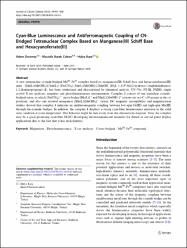| dc.contributor.author | Dönmez, Adem | |
| dc.contributor.author | Çoban, Mustafa Burak | |
| dc.contributor.author | Kara, Hülya | |
| dc.date.accessioned | 2020-11-20T14:49:45Z | |
| dc.date.available | 2020-11-20T14:49:45Z | |
| dc.date.issued | 2018 | |
| dc.identifier.issn | 1040-7278 | |
| dc.identifier.issn | 1572-8862 | |
| dc.identifier.uri | https://doi.org/10.1007/s10876-018-1404-4 | |
| dc.identifier.uri | https://hdl.handle.net/20.500.12809/1320 | |
| dc.description | 0000-0002-2032-8930 | en_US |
| dc.description | WOS: 000446704800003 | en_US |
| dc.description.abstract | A new tetranuclear cyanide-bridged Mn-III-Fe-III complex based on manganese(III) Schiff base and hexacyanoferrate(III) units, [Mn(L)(MeOH)(2)][{Mn(L)}{Fe(CN)(6)}{Mn(L)(MeOH)}]center dot 2MeOH, [H2L=N,N'-bis(2-hydroxy-1-naphthalidenato)-1,2-diaminopropane] (1), has been synthesized and characterized by elemental analysis, UV-Vis, FT-IR, PXRD, single crystal X-ray analyses, magnetic and photoluminescence measurements. Complex 1 consist of one trinuclear cyanido-bridged anion, in which [Fe(CN)(6)](3-) anion bridge [Mn(L)](+) and Mn(L)(MeOH)}](+) cations via two C equivalent to N groups in the cis positions, and also one isolated manganese [Mn(L)(MeOH)(2)](+) cation. DC magnetic susceptibility and magnetization studies showed that complex 1 indicates an antiferromagnetic coupling between low-spin Fe(III) and high-spin Mn(III) through the cyanide bridges. In addition, the complex 1 displays a strong cyan-blue luminescence emission in the solid state condition at room temperature. This behavior might be seen easily from the chromaticity diagram. Thus, the complex may be a good promising cyan-blue OLED developing electroluminescent materials for flatted or curved panel display applications due to the fact that it has such features. | en_US |
| dc.description.sponsorship | Research Funds of Mula Stk Kocman University [BAP-2018/008] | en_US |
| dc.description.sponsorship | The authors are grateful to the Research Funds of Mula Stk Kocman University (BAP-2018/008) for the financial support and Balikesir University, Science and Technology Application and Research Center (BUBTAM) for the use of the Photoluminescence Spectrometer. The authors are also very grateful to Prof. Dr. Andrea Caneschi (Laboratory of Molecular Magnetism, Department of Chemistry, University of Florence) for the use of SQUID magnetometer and helpful suggestions. | en_US |
| dc.item-language.iso | eng | en_US |
| dc.publisher | Springer/Plenum Publishers | en_US |
| dc.item-rights | info:eu-repo/semantics/openAccess | en_US |
| dc.subject | Magnetism | en_US |
| dc.subject | Photoluminescence | en_US |
| dc.subject | X-Ray Analyses | en_US |
| dc.subject | Cyano-Bridged | en_US |
| dc.subject | Mn-III-Fe-III Compound | en_US |
| dc.title | Cyan-Blue Luminescence and Antiferromagnetic Coupling of CN-Bridged Tetranuclear Complex Based on Manganese(III) Schiff Base and Hexacyanoferrate(III) | en_US |
| dc.item-type | article | en_US |
| dc.contributor.department | MÜ, Fen Fakültesi, Fizik Bölümü | en_US |
| dc.contributor.institutionauthor | Dönmez, Adem | |
| dc.contributor.institutionauthor | Kara, Hülya | |
| dc.identifier.doi | 10.1007/s10876-018-1404-4 | |
| dc.identifier.volume | 29 | en_US |
| dc.identifier.issue | 6 | en_US |
| dc.identifier.startpage | 951 | en_US |
| dc.identifier.endpage | 958 | en_US |
| dc.relation.journal | Journal of Cluster Science | en_US |
| dc.relation.publicationcategory | Makale - Uluslararası Hakemli Dergi - Kurum Öğretim Elemanı | en_US |


















